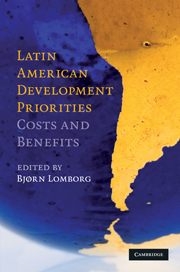Book contents
- Frontmatter
- Contents
- List of figures
- List of tables
- List of contributors
- Acknowledgments
- Abbreviations and acronyms
- Expert panel findings
- Introduction
- Democracy
- 1 Democracy in the LAC region, challenges and solutions: political party and party system institutionalization and women's legislative representation
- Education
- Employment and social security
- Environment
- Fiscal problems
- Health
- Infrastructure
- Poverty
- Public administration
- Violence and crime
- Conclusion
- References
1 - Democracy in the LAC region, challenges and solutions: political party and party system institutionalization and women's legislative representation
Published online by Cambridge University Press: 05 June 2012
- Frontmatter
- Contents
- List of figures
- List of tables
- List of contributors
- Acknowledgments
- Abbreviations and acronyms
- Expert panel findings
- Introduction
- Democracy
- 1 Democracy in the LAC region, challenges and solutions: political party and party system institutionalization and women's legislative representation
- Education
- Employment and social security
- Environment
- Fiscal problems
- Health
- Infrastructure
- Poverty
- Public administration
- Violence and crime
- Conclusion
- References
Summary
Introduction
The countries of the LAC region confront numerous challenges to the quality of their democracies. A 2006 survey conducted by the Research Department (RES) at the Inter-American Development Bank evaluated the challenges faced by the region in sixteen thematic areas, one of which was democracy (Berkman and Cavallo 2006). Among the sixteen thematic areas, democracy was considered by the respondents to represent one of the top ten problems faced by the region, and the survey evaluated six principal challenges to democracy, in order of importance for the survey respondents: “Little real enforcement of rules and accountability for politicians,” “Weak democratic culture,” “Crisis of representation,” “Political intimidation and violence,” “Traditional parties losing traditional constituencies,” and “No real separation of powers.”
The challenges that LAC democracies face today are very real, and quite daunting. However, when discussing them, and any potential solutions, we must be cognizant of the considerable diversity in the objective conditions of the region's democracies. The extent and nature of any specific challenge varies considerably, depending on the country in question. Therefore any solution offered to a challenge will vary in many important respects, depending on country-specific factors (Spiller and Tommasi 2007; Stein and Tommasi 2008).
- Type
- Chapter
- Information
- Latin American Development PrioritiesCosts and Benefits, pp. 13 - 44Publisher: Cambridge University PressPrint publication year: 2010
References
- 1
- Cited by



